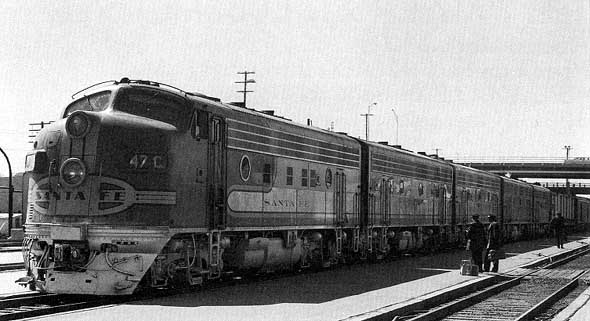|
When more regular passenger units were delivered in late 1952, the dual service geared units were renumbered into a separate class units 325LAB through 335LAB, and the new 100 MPH units took the vacated numbers 306LAB through 314LAB. More dual service 325 class locomotives were delivered in 1953 numbered 336LAB through 340LAB and 341LA through 344LA. Intended primarily as protection power in case of failure of a normal passenger locomotive the units of this class did spend a considerable portion of their time in freight service, even in their early years. 325 class units had three variations in appearance. Units 326LAB through 331LAB had 36" D/B fans and horizontal slit grilles, making these units identical to both the Athern and Stewart models. Units 325LAB and 332LAB through 335LAB had 36" D/B fans and vertical slit grilles. Units 336LAB and upwards had a 48" D/B fan and vertical slit grilles as in the late 37 class. If you want to leave your Stewart or Athern passenger F-7's unmodified you will need to number them in the 326LAB through 331LAB group as these seem to be the only passenger F7's built with the same appearance as these models. |
 F7 47C was the last A-unit of the 37 class. She guides her train to a stop at Albuquerque in April 1966. Lower headlight has been equipped with twin seal-beam lamps. Note the container mail cars. |
|
Class engine 325 was most likely built with vertical slit grilles as photos of it as early as 1950 show it with that type. The vertical slit grille was apparently used on most Santa Fe passenger F's except the 326 through 331 sets, but photo show that a few other units acquired horizontal slit grilles during shop visits. Photos of 31LA, 35LABC, and 303L show that they had horizontal slit grilles at one time or another, other units probably did also, but all seem to have ended up with vertical slit grilles. Apparently the only sure way to determine what type of grille any given locomotive had at a particular time is to use photos for reference. Some passenger F3's are also known to have acquired D/B fans at some point in their careers as well, and some units originally equipped with 36" D/B fans had them replaced with 48" fans during shopping or wreck rebuilds. As with the freight F's and the 16 class passenger F's the 300 and 325 class units underwent modifications over the years. Different air horns were installed, grab irons were added above the windshield and up the right side of the nose and radio antennas were installed. Most of them had wrecking lugs and nose MU installed on the A-units, and all had the fuel tank skirting removed. Photographs are a "must" to determine how any given unit was equipped. The 16, 37, 300 and 325 classes remained pretty much intact aside from normal attrition through early 1971. When Amtrak took over passenger service in May 1971, surviving units of the 16 and 37 classes that were to be used in Amtrak service were renumbered into the 300 class. A-units filled some previously vacated "L" numbers as well as newly created numbers 300C through 314C plus 315L. B-units filled vacated numbers and spilled over into the 315AB through 321AB numbers. The 325 class was retained by the Santa Fe for freight service and was not used by Amtrak. |







